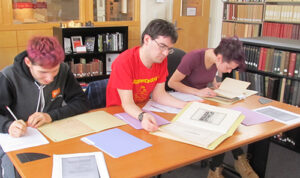 For Deborah Douglas’ History of MIT class, in which students examine the Institute’s past, the Institute Archives and Special Collections serves as a vital resource for their explorations. Douglas, the director of collections at the MIT Museum (where students also study key artifacts), recently shared why working in the Archives opens up new modes of learning for her students.
For Deborah Douglas’ History of MIT class, in which students examine the Institute’s past, the Institute Archives and Special Collections serves as a vital resource for their explorations. Douglas, the director of collections at the MIT Museum (where students also study key artifacts), recently shared why working in the Archives opens up new modes of learning for her students.
Q: Why is it important for students to study original documents?
A: Original materials are thrilling to work with! In every history class I have taught, I get students using primary sources. At the Archives, my students got to see William Barton Rogers’ 1846 letter to his brother, Henry. This is very important, as it is the first expression of a vision for a new kind of educational institution, and every one of them got to touch it and attempt to read it. They learned that Rogers had terrible penmanship. I guarantee that they will remember this forever (but wouldn’t have if I had just stated that as an aside in lecture).
Q: What do you notice about the way they interact with the documents?
A: My wonderful students bring all sorts of sensibilities to the documents. Initially, everything surprises them: “They seem to be required to take the same courses as our GIRs,” “Hey, they are complaining about not getting enough sleep,” “I didn’t know that [fill in the blank] existed back then,” and so on. Then they get curious and discover they can look things up. Finally, they realize that they can learn much more than what the words on the page say. It takes time for that process to unfold, but it’s magical to see.
Q: What skills do you want students to take away from working with the archives?
A: In terms of skills, I want students to:
- learn what an archive is
- learn how to access one and how they work
- learn how to find materials
- most importantly, learn how to investigate and answer questions that matter deeply to them.
In terms of document analysis, I want them to learn that good history entails the systematic and careful analysis of evidence.
Q: Many people think of MIT as being forward-looking. Why is it important for students to understand the history of the Institute?
A: For me, the course is about discovery, exploration, adventure, learning, creative thinking, and the synthesis of big ideas. It is about the importance of the research university: what it has been in the past and what it will be in the future. And, it is about identity — institutional and individual — which is an intriguing way to teach history. Practically speaking, I hope students improve at synthesizing information from diverse sources about science, technology, and culture. When you care passionately about a subject — the way they care about MIT — those lessons are more deeply held and meaningful.
—
“Looking at artifacts allows you to imagine their place in history. I feel like an investigator trying to put together the pieces of a puzzle.” — Brandon McKenzie, student
